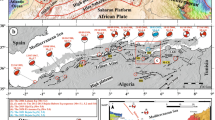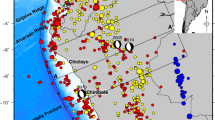Abstract
From 26 April to 8 May 2020, an earthquake sequence occurred in the Haenam region in southwestern Korea. The main shock with a moment magnitude of 3.2 occurred on 3 May. It was preceded by 38 foreshocks that occurred over a week, with magnitudes ranging from 0.8 to 2.7, and was followed for another week by 35 aftershocks with magnitudes ranging from 0.5 to 2.4. The P-wave first-motion indicates that the focal mechanism of the mainshock was a strike of 193° or 102°, a dip of 83° or 78°, and a rake of –168° or –7°. The stress orientation of the focal mechanism is consistent with the regional tectonic stress field. Spectral analysis of the mainshock indicates that it occurred on a fault with a radius of 216 ± 4.58 m and a stress drop of 31.4 ± 2.35 bar. The hypocenters of the sequence, determined using the double-difference method, were shown to cluster along a trend striking 100° and dipping 65° to the south at a depth of 20.1 ± 0.05 km, which indicates that the earthquakes in the sequence occurred within a rupture radius of the mainshock. Detailed seismic analysis of the sequence indicates that closely located subfaults or small weak zones were related to the mainshock.
Similar content being viewed by others
References
Boatwright, J., 1980, A spectral theory for circular seismic sources; sim¬ple estimates of source dimension, dynamic stress drop, and radi¬ated seismic energy. Bulletin of the Seismological Society of America, 70, 1–27.
Brune, J.N., 1970, Tectonic stress and the spectra of seismic shear waves from earthquakes. Journal of Geophysical Research, 75, 4997–5009.
Chang, C., Lee., J.B., and Kang, T.-S., 2010, Interaction between regional stress state and faults: complementary analysis of borehole in situ stress and earthquake focal mechanism in southeastern Korea. Tec-tonophysics, 485, 164–177.
Chang, S.-J. and Baag, C.-E., 2006, Crustal structure in southern Korea from joint analysis of regional broadband waveforms and travel times. Bulletin of the Seismological Society of America, 98, 856–870.
Choi, P., Hong, S.H., and Lee, B.-J., 1992, Geometry of fault drag: an attempt to determine the theoretical dip and slip vector of the Kwangju fault. Journal of the Geological Society of Korea, 28, 483–490.
Christensen, N.I. and Mooney, W.D., 1995, Seismic velocity structure and composition of the continental crust: a global view. Journal of Geophysical Research, 100, 9761–9788.
Hanks, T.C. and Kanamori, H., 1979, A moment magnitude scale. Jour¬nal of Geophysical Research, 84, 2348–2350.
Hardebeck, J.L. and Shearer, P.M., 2002, A new method for determin¬ing first-motion focal mechanisms. Bulletin of the Seismological Society of America, 92, 2264–2276.
Hartzell, S.H., 1978, Earthquake aftershocks as Green’s functions. Geo¬physical Research Letters, 5, 1–4.
Kanamori, H., 1994, Mechanics of earthquakes. Annual Review of Earth and Planetary Sciences, 22, 207–237.
Keilis-Borok, V.I., 1959, On the estimation of the displacement in an earthquake source and of source dimensions. Annals of Geophys¬ics, 12, 205–214.
Kihm, Y.H., Choi, P.-Y., Hwang, J.H., Kim, H., Ko, K., and Chun, H.Y., 2014, Geological report of the Mokpo sheet (1:50,000). Korea Institute of Geoscience and Mineral Resources, Daejeon, 93 p (in Korean with English abstract).
Kim, S.K. and Jung, B.H., 1985, Crustal structure of the southern part of Korea. Journal of the Korean Institute of Mining Geology, 18, 151–157.
Kim, S., Rhie, J., and Kim, G., 2011, Forward waveform modelling pro¬cedure for 1-D crustal velocity structure and its application to the southern Korean Peninsula. Geophysical Journal International, 185, 453–468.
Kim, W.-Y., Choi, H., and Noh, M., 2010, The 20 January 2007 Odaesan, Korea, earthquake sequence: reactivation of a buried strike-slip sault? Bulletin of the Seismological Society of America, 100, 1120–1137.
Kwon, B.D., Joo, J.A., and Kwon, J., 1993, Geophysical studies on major faults in the Ogcheon belt: gravity survey on the faults at Muan and Haenam Areas. Journal of the Geological Society of Korea, 29, 281–290.
Lanza, V., Spallarossa, D., Cattaneo, M., Bindi, D., and Augliera, P., 1999, Source parameters of small events using constrained deconvolu-tion with empirical Green’s functions. Geophysical Journal Interna¬tional, 137, 651–662.
Lee, K., 1979, On crustal structure of the Korean Peninsula. Journal of the Geological Society of Korea, 15, 253–258.
Lahr, J.C., 1999, HYPOELLIPSE: a computer program for determining local earthquake hypocentral parameters, magnitude, and first-motion pattern. USGS Open-File Report, 99-23, version 1.1., U.S. Geologi¬cal Survey, Reston, 119 p.
Madariaga R., 1976, Dynamics of an expanding circular fault. Bulletin of the Seismological Society of America, 66, 639–666.
Mori, J. and Frankel, A., 1990, Source parameters for small events asso¬ciated with the 1986 North Palm Springs, California, earthquake determined using empirical Green’s functions. Bulletin of the Seis-mological Society of America, 80, 278–295.
Rhee, H.M. and Sheen, D.H., 2016, Lateral variation in the source parameters of earthquakes in the Korean Peninsula. Bulletin of the Seismological Society of America, 106, 2266–2274.
Salvatier, J., Wiecki, T.V., and Fonnesbeck, C., 2016, Probabilistic pro¬gramming in Python using PyMC3. PeerJ Computer Science 2, e55. https://doi.org/10.7717/peerj-cs.55
Waldhauser, F. and Ellsworth, W.L., 2000, A double-difference earth¬quake location algorithm: method and application to the northern Hayward fault, California. Bulletin of the Seismological Society of America, 90, 1353–1368.
Acknowledgments
The author would like to thank Dahyun Kwak, Hyeji Lee, and SeongJin Kim for helping with the acquisition of waveform data, and the Korea Meteorological Administration for providing the microearthquake catalog and making seismograms available. The author is also grateful to Min Huh and Jongyun Jung, who provided information about the geological background for the epicentral region. This work was funded by the Korea Meteorological Administration under Grant KMI2018-00911.
Author information
Authors and Affiliations
Corresponding author
Additional information
Publisher’s Note
Springer Nature remains neutral with regard to jurisdictional claims in published maps and institutional affiliations.
Rights and permissions
About this article
Cite this article
Sheen, DH. Analysis of the 2020 Haenam, Korea, earthquake sequence. Geosci J 25, 33–42 (2021). https://doi.org/10.1007/s12303-020-0038-3
Received:
Accepted:
Published:
Issue Date:
DOI: https://doi.org/10.1007/s12303-020-0038-3




